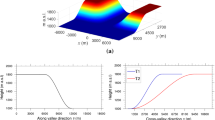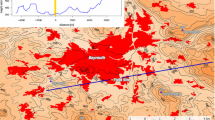Summary
Features of the mean flow structure in a small valley system in the Rosalian mountain range are discussed using data from a wind measurement network. Tethered balloon measurements during periods of clear sky form the basic dataset for the analysis of drainage winds and temperature inversions. During periods of weak ambient winds the existence of a pure thermally driven nocturnal valley wind system is shown. With strong ambient winds opposing the drainage flow, a reduced drainage height but the same jet maximum as with weak ambient winds is found. On the other hand with “aiding” flow the drainage winds are suppressed and flow reversal can occur. This strong valley flow interaction with the ambient wind indicates considerable dynamic influence on the evolution of drainage winds and on the breakup of temperature inversion structure for small valleys.
Similar content being viewed by others
References
Barr, S., Orgill, M. M., 1989: Influence of external meteorology on nocturnal valley drainage winds.J. Appl. Meteor. 28, 497–517.
Bernhofer, Ch., McKee, T. B., 1984: Nocturnal mass budget in a well drained windening valley. Proceedings of the 18th Conf. for Alpine Meteor., Obatija.Zbornik meteoroloskih i hidroloskih radova 10, 164–168.
Bernhofer, Ch., Garaus, T., Laube, W., 1988: Standortspezifische Aspekte des Waldsterbens: Ergebnisse von zwei Meßtürmen im Lehrforst Rosalia. In: Führer, E., Neuhuber, F. (Hrsg.)Bericht FIW-Symposium: Waldsterben in Österreich. Theorie, Tendenz, Therapien. 27./28. Okt. Wien, 87–101.
Bernhofer, Ch., Laube, W., 1989: The Rosalian research station (Austrian Research Program against Forest Decline). Commission of the European Communities, Report COST — Workshop Monitoring Air Pollution and Forest Ecosystem Research, 20./21. Feb., Bilthiven, The Netherlands, 80–85.
Bernhofer, Ch., Mursch-Radlgruber, E., Moritz, E., Pöschl, P., Zarpas, A., 1993: Aspekte der Mikrometeorologie von Waldbeständen unter komplexen Standortsbedingungen. Endbericht Forschungsprojekt No 7951-GEO des Fonds zur Förderung wissenschaftlicher Forschung, Wien, pp. 150.
Blumen, W. (ed.), 1990:Atmospheric Processes over Complex Terrain. (Meteorological Monographs Vol. 23, Nr. 45) Bosten, MA: Amer. Meteor. Soc..
Clements, W. E., Archuleta, J. A., 1989: Experimental design of the ASCOT field study.J. Appl. Meteor. 28, 405–413.
Clements, W. E., Archuleta, J. A., Hoard, D. E., 1989: Mean structure of the nocturnal drainage in a deep valley.J. Appl. Meteor. 28, 457–462.
Dobesch, H., Neuwirth, F., 1982: Wind in Niederösterreich, insbesondere im Wiener Becken und im Donautal.Arbeiten aus der Zentralanstalt für Meteorologie und Geodynamik 54, 212.
Freitag, C., 1987: Atmosphärische Grenzschicht in einem Gebirgstal bei Berg- und Talwind. Wiss. Mit. des Meteor. Inst. Univ. München, Nr 60, pp. 197.
McKee, T. B., O'Neal, R. D., 1989: The role of valley geometry and energy budget in the formation of nocturnal valley winds.J. Appl. Meteor. 28, 445–456.
Mursch-Radlgruber, E., 1993: Mobile high frequency minisodar and its potential in boundary layer studies.J. Appl. Physics B,57, 57–63.
Neff, W. D., King, C. W., 1988: Observations of complex terrain flows using acoustic sounders: drainage flow structure and evolution.Bound.-Layer Meteor. 43, 15–41.
Neff, W. D., 1990: Remote sensing of atmospheric complex terrain. In: Blumen W. (ed.)Atmospheric Processes over Complex Terrain. (Meteorological Monographs, AMS, 23, 45), 173–228.
Steinacker, R., 1984: Real-height distribution of a valley and its relation to the valley wind.Contrib. Atmos. Physics 51(1), 64–71.
Vergeiner, I., 1983: Dynamik alpiner Windsysteme. Endbericht Forschungsprojekt No 3556 des Fonds zur Förderung wissenschaftlicher Forchung, Innsbruck, pp. 129.
Vergeiner, I., Dreiseitl, E., 1987: Valley winds and slope winds: Observations and elementary thoughts.Meteorol. Atmos. Phys. 36, 264–286.
Whiteman, C. D., 1982: Breakup of temperature inversions in deep mountain valleys: Part I. Observations.J. Appl. Meteor. 21, 270–289.
Whiteman, C. D., 1990: Observations of thermally developed wind systems in mountainous terrain. In: Blumen, W.,Atmospheric Processes over Complex Terrain. (Meteorological Monographs, AMS, 23, 45), 5–42.
Whiteman, C. D., Barr, S., 1986: Atmospheric mass transport by along-valley wind systems in a deep Colorado valley.J. Appl. Meteor. 25, 1205–1212.
Author information
Authors and Affiliations
Additional information
With 15 Figures
Rights and permissions
About this article
Cite this article
Mursch-Radlgruber, E. Observations of flow structure in a small forested valley system. Theor Appl Climatol 52, 3–17 (1995). https://doi.org/10.1007/BF00865503
Received:
Revised:
Issue Date:
DOI: https://doi.org/10.1007/BF00865503




